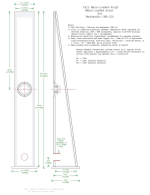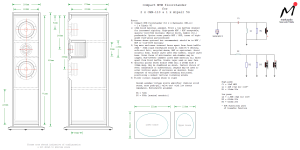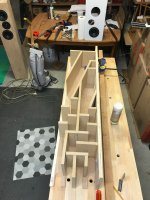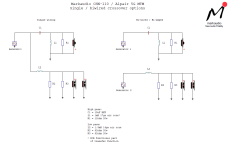I guess I am taller or (as has been said to me) I look more arrogant because I tilt my head up, but this is about listening axis to me. Or, my sofa is higher. 😉
I roll my own usually, but I thoroughly enjoy the little massloaded quarter wave horn you designed for the CHN50.
I roll my own usually, but I thoroughly enjoy the little massloaded quarter wave horn you designed for the CHN50.
...and because nobody asked for it (well, nobody here anyway) -a tall CHR-120 ML-Voigt / ML-horn for those who like them, and prefer a driver located above an average seated listening axis:
Scott,
On the topic of ML-Voigt designs done by you, wasn't there one for the Alpair 12 also? I've forgotten the name though...
...and as a sneak preview, with the new glass cone Alpair 5G:
Compact MTM floorstander. External dimensions were inspired by an old Linn design, although the construction, internals, drivers, loading & filter are all completely different. Latter is another '60s - '70s JBL inspired type, designed for a reasonable front hemisphere power-response & vertical window since this would otherwise be rather short for an MTM. I like the proportions (although don't take my rotten sketches too literally -they're just indicative of the dimensions, not shown to scale -other than the driver drawings, which are by Dave, and therefore excellent! 😉 ).
Compact MTM floorstander. External dimensions were inspired by an old Linn design, although the construction, internals, drivers, loading & filter are all completely different. Latter is another '60s - '70s JBL inspired type, designed for a reasonable front hemisphere power-response & vertical window since this would otherwise be rather short for an MTM. I like the proportions (although don't take my rotten sketches too literally -they're just indicative of the dimensions, not shown to scale -other than the driver drawings, which are by Dave, and therefore excellent! 😉 ).
Attachments
Mmmmtm
I often wondered what an ariel 6 would sound like with MA drivers, but never got round to trying it. The ariel was my favourite of the speakers I built and Lynn gave me permission to build them commercially, but I never got round to selling any. I got loads of enquiries though, but no follow throughs.
Maybe somebody will be tempted one day.
p.s unless somebody already has, and I've missed it.
I often wondered what an ariel 6 would sound like with MA drivers, but never got round to trying it. The ariel was my favourite of the speakers I built and Lynn gave me permission to build them commercially, but I never got round to selling any. I got loads of enquiries though, but no follow throughs.
Maybe somebody will be tempted one day.
p.s unless somebody already has, and I've missed it.
Nice! Must be the Keilidh. I've never heard them, but IIRC @chrisb had a pair back in the day.External dimensions were inspired by an old Linn design
jeff
Had to search for the dimensions before piping in with a response, but yeah those are the dimensions of the Keilidh - introduced in 1992. They were the last commercial speaker I bought - along with an LP12 and the cute little Intek amp circa ‘93 or so.
Those familiar with Linn’s upgrade path might remember that they offered a replacement tweeter after a few years, and ended up recycling the originals from mine in my first DIY build, which was coincidentally somewhat inspired by Lynn’s Ariels. The rest, as they say, is infamy.
Another interesting design, Scott, and the crossover certainly looks less complicated than I remember from the Linns; of course part of their strategy was to isolate the passband sections to accommodate multiple amps in either passive or fully active mode.
Those familiar with Linn’s upgrade path might remember that they offered a replacement tweeter after a few years, and ended up recycling the originals from mine in my first DIY build, which was coincidentally somewhat inspired by Lynn’s Ariels. The rest, as they say, is infamy.
Another interesting design, Scott, and the crossover certainly looks less complicated than I remember from the Linns; of course part of their strategy was to isolate the passband sections to accommodate multiple amps in either passive or fully active mode.
I loved the looks of the Keilidh more than any speakers in the mags. Checked A5G not available yet. Thanks @Scottmoose for the preview and design.
And if I were to consider a used pair, what should I look (out) for? Tweeters still 3/4in ceramic dome? Thanks.Those familiar with Linn’s upgrade path might remember that they offered a replacement tweeter after a few years
Last edited:
It's definitely a thought. Different type of design to the Vifa P13s, but no reason they can't be used to load a suitable pipe; it's been a while since I looked at the different Ariels. Might take a look at their geometry & see what fits these days. 🙂Mmmmtm
I often wondered what an ariel 6 would sound like with MA drivers, but never got round to trying it. The ariel was my favourite of the speakers I built and Lynn gave me permission to build them commercially, but I never got round to selling any. I got loads of enquiries though, but no follow throughs.
Maybe somebody will be tempted one day.
p.s unless somebody already has, and I've missed it.
With anything in particular?
I've been going over the different variations, & it reminded me of something I was looking at a few years back. The independent pipes came about because in earlier versions, Lynn was trying to combine two dissimilar length pipes about halfway down the box into a single, and was getting some destructive interference as a result. The independent lines was a solution to that; works fine in itself of course, although no opportunity for offsets etc., but arguably a simpler solution to the issue would have been to remove two internal panels from the existing v3 encosure so the drivers shared a common upper chamber like a Bailey / Radford / Daline & fed a single pipe / line / labyrinth. Problem solved. Still, it ended up as it ended up & it worked decently, so not much point speculating on 'what ifs'. 😉
I've been going over the different variations, & it reminded me of something I was looking at a few years back. The independent pipes came about because in earlier versions, Lynn was trying to combine two dissimilar length pipes about halfway down the box into a single, and was getting some destructive interference as a result. The independent lines was a solution to that; works fine in itself of course, although no opportunity for offsets etc., but arguably a simpler solution to the issue would have been to remove two internal panels from the existing v3 encosure so the drivers shared a common upper chamber like a Bailey / Radford / Daline & fed a single pipe / line / labyrinth. Problem solved. Still, it ended up as it ended up & it worked decently, so not much point speculating on 'what ifs'. 😉
Right, I keyed off the Keilidh's external dimensions, as I quite like them, although having pulled about four pairs apart, the internal dimensions & construction are completely different.Had to search for the dimensions before piping in with a response, but yeah those are the dimensions of the Keilidh - introduced in 1992. They were the last commercial speaker I bought - along with an LP12 and the cute little Intek amp circa ‘93 or so.
Those familiar with Linn’s upgrade path might remember that they offered a replacement tweeter after a few years, and ended up recycling the originals from mine in my first DIY build, which was coincidentally somewhat inspired by Lynn’s Ariels. The rest, as they say, is infamy.
Another interesting design, Scott, and the crossover certainly looks less complicated than I remember from the Linns; of course part of their strategy was to isolate the passband sections to accommodate multiple amps in either passive or fully active mode.
Re the filter -no big deal there, as far as passive filtering goes, the isolation of the HP / LP legs is more a case of how it's drawn or physically wired / printed on a circuit board than anything fundamental to the design. For biwiring, just assume the branch off before C1 is the 2nd pair of leads. Or you can just split it per attached.
The A5G is being crowd-funded in Japan (that was a new one on me too); hopefully will shortly be available. I try to keep all the filters for these fairly simple, partly because I tend to think the driver types suit them, just as they did back in the '40s - '70s, but also because Markaudio don't like things to get too complicated in case it frightens potential buyers, which from a commercial POV is understandable.
Hmm. I rather enjoyed doing this one though. Might have to look at a few wider types with Seas / Scan etc. options, just to keep the old hand in...
Attachments
If anybody is interested here is the build detail for ariels. It's almost 25 years and a lot of speakers down the line, but this one still holds up:
http://www.vitalstates.org/diy/ariel/vsl-ariel.htm
http://www.vitalstates.org/diy/ariel/vsl-ariel.htm
I still remember hearing yours in your loft studio & thinking they were doing much of what electrostatics do. Not exactly the same, but IIRC that was Lynn's intent & to my ears he achieved it, so long as you stayed within the vertical axis. Impressed then, still impressed now. 🙂 Don't tell anybody, but I might have aimed for some of the same balance (though not the same filter frequency -different driver types after all) with these little guys. 😉
What do you think about CHP90 instead Vifa P13WH? Would it work in Ariels? Im trying to find sourrounds for my Vifa woofers since they got stiff but no luck.
Sorry, can’t offer anything valuable there - that was close to 30years ago, and I’m notorious for not taking notes or often even build progress photos.I loved the looks of the Keilidh more than any speakers in the mags. Checked A5G not available yet. Thanks @Scottmoose for the preview and design.
And if I were to consider a used pair, what should I look (out) for? Tweeters still 3/4in ceramic dome? Thanks.
- Home
- Loudspeakers
- Full Range
- Miscellaneous designs - Markaudio, Fostex, TB, Dayton, SEAS etc



